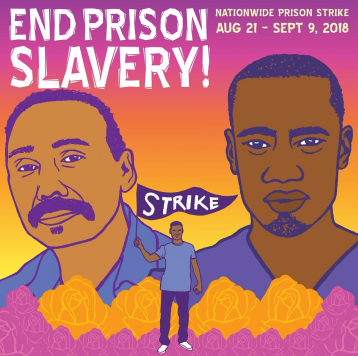What you need to know about the National Prison Strike

Informational poster for the National Prison Strike (https://incarceratedworkers.org/campaigns/prison-strike-2018)
Since the emancipation proclamation, many different ways have been employed to exploit marginalized communities. One of these ways that is still existent in modern times is prison labor. This is in addition to the inhumane treatment received by those who are incarcerated. Incarcerated people are taking a stand from August 21 to September 9, 2018, against mistreatment in prisons. This strike, organized by the Incarcerated Workers Organizing Committee, has spread through the nation’s prisons.
Prisoners are demanding a definite end to labor with low wages and no benefits. They are demanding a stop to what some may call “modern-day slavery”. This nationwide strike is in response to an incident in a South Carolina Facility that occurred on April 2, 2018, in which at least 7 prisoners died and 22 more were injured. It was stated that prison guards and other staff made no attempts to break up a fight between many inmates until many hours later when it was too late. Although many speculate this to be the prisoner’s fault, the state of the facilities and the treatment inmates receive can be far from humane. Due to this extensive mistreatment, incarcerated people are calling for “immediate improvements to the conditions of prisons and prison policies that recognize the humanity of imprisoned men and women” as their number one demand. Those who feel passionate about the cause are able to help in a variety of ways as found on the official prison strike website. These ways include “phone zaps” which entail calling prisons and demanding better treatment. Another way that people are able to help is to write letters to prisoners on strike that are “facing retaliation”. This keeps spirits high among strikers and fans the flames of the movement. Lastly, one can donate money to the strike to fund the ongoing efforts to make prisons more rehabilitative. Through media coverage and celebrity endorsements, the movement has gained plenty of momentum.
Prison labor is no small problem, it effects millions of incarcerated Americans. But why so many? Due to the privatization of the prison industry since the Nixon era, much of the focus has been to fill up prisons instead of rehabilitate those who are incarcerated. In fact, Nixon’s aide, Enrichlman said that while they could not criminalize a race, they could “associate the hippies with marijuana and blacks with heroin. And then criminalizing both heavily, [they] could disrupt those communities”. One in three black males born today will be incarcerated in their lifetime which is three times as much as their white counterparts. One in five inmates have not been convicted of a crime but cannot afford bail. Both this racism and classism fills American prisons to the brim with no intention of rehabilitating those who are incarcerated. The United States has 4% of the world’s population but is home to 25% of the world’s population and that is no coincidence. With well over 2 million prisoners in our country, this prison strike may turn heads and begin to unravel the tangle this country has been in for far too long.
More details to come through the Incarcerated Workers Organizing Committee.
Sources:
https://www.cnn.com/2016/03/23/politics/john-ehrlichman-richard-nixon-drug-war-blacks-hippie/index.html
